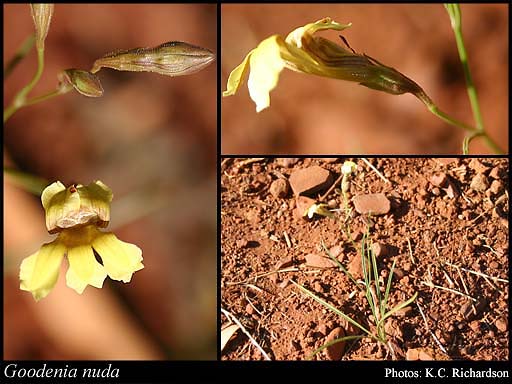- Reference
- Bot.Jahrb.Syst. 35:562 (1905)
- Conservation Code
- Not threatened
- Naturalised Status
- Native to Western Australia
- Name Status
- Current
Erect to ascending herb, to 0.5 m high. Fl. yellow, Apr to Aug.

Scientific Description
Stems unribbed. Leaves flat, 25-110 mm long, 0.6-2 mm wide, Indumentum absent (leaves glabrous) or present, with sparse, simple hairs; margins entire or toothed. Bracteoles absent. Pedicel pedicellate, Pedicel length the pedicels 30-50 mm long, glabrous. Calyx lobes present, Calyx length 3-4 mm long, hairy, with sparse, simple hairs. Corolla yellow, 16-22 mm long, auriculate, not spurred, hairy on the outside, with sparse, simple hairs, hairy on the inside; central lobes 7-9 mm long, with wings; outer lobes 9-13 mm long, wings present on both sides, 1-1.5 mm wide. Anthers free. Ovary inferior, not gibbose; style 8.5-9 mm long, hairy; indusium single, hairy; ovules more than two. Flowers in April, May, June, July and August. Occurs in the Pilbara (PIL) IBRA Region(s), of the Eremaean (E) Botanical Province. Conservation Code: Conservation code Priority Four (P4).
Distribution
- IBRA Regions
- Gascoyne, Little Sandy Desert, Murchison, Pilbara.
- IBRA Subregions
- Augustus, Carnegie, Chichester, Eastern Murchison, Fortescue, Hamersley, Roebourne, Trainor.
- Local Government Areas (LGAs)
- Ashburton, East Pilbara, Karratha, Meekatharra, Port Hedland, Sandstone, Upper Gascoyne, Wiluna.